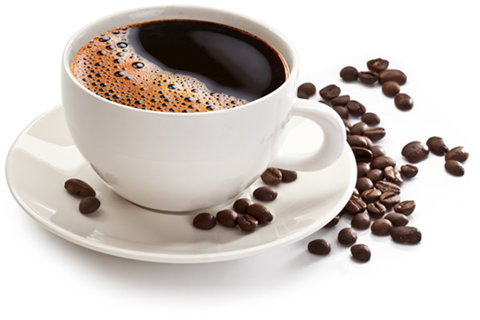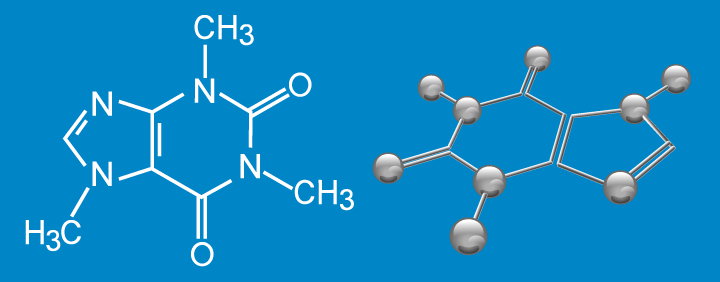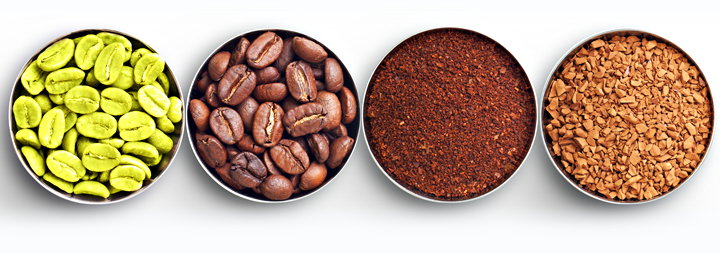Often, very often, nature offers us a multitude of substances that can have a variety of uses in our daily lives, so much so that they can become unmissable habits of consumption, thanks to the benefits that we can enjoy.
One of the most popular, to the point of being a real daily habit for many people, is caffeine, in the "guise" of a tasty cup of coffee.
In addition to precisely characterising a moment or various moments throughout the day, the main characterising substance is a true concentrated psychostimulant and more besides, easily creating addicts (myself among them!).
Thanks to this and other reasons, it has been part of the arsenal for bodybuilding and sporting enthusiasts in general for years now, as well as being a useful support for students during intensive phases of study.
What is caffeine?
Let's begin first with the fact that Caffeine is a "xanthine", an alkaloid which is found in several plants such as coffee beans, cocoa beans, tea leaves, guarana berries and kola nuts, which are added to soft drinks and used in different pharmaceutical drugs as well.
The average caffeine content is about 85 mg per 150 ml (1 cup) in our beloved roasted ground coffee, 60 mg in instant coffee, 3 mg in decaffeinated coffee, 30 mg in leaf tea or tea bags, 20 mg in instant tea and 4 mg in cocoa or hot chocolate.
A glass (200 ml) of a soft drink containing caffeine, has an average caffeine content of about 20-60 mg.
In Europe, adults consume a daily average of 200 mg (with a range between 100-400 mg), which is, for the most part, derived from coffee and tea, but also from alcohol-free drinks including "energy drinks".
| Food | Caffeine content |
| Mug of decaffeinated coffee | 3mg |
| Hot chocolate | 4mg |
| Instant tea | 20 mg |
| Tea-bag | 30 mg |
| Cup of instant coffee | 60 mg |
| Glass of soft drink with caffeine | 20-60mg |
| Cup of ground roasted coffee (150ml) | 85mg |
However, the dose depends greatly on cultural habits (which we Italians know something about!).
Northern European countries are known for their beverages with a high caffeine content: the average consumption of caffeine reaches 400 mg per day in Denmark, Finland, Norway and Sweden.
Children, adolescents and coffee abstainers ingest caffeine mostly in the form of tea and soft drinks.
Caffeine's mechanism of action
After intake, caffeine is rapidly absorbed from the stomach and small intestine, with a peak reached within half an hour.
Once in circulation, brain stimulation is the first tangible sign of the power of this substance, because unless the person is completely addicted, a small "energy bang" is felt.
We will then notice a simultaneous improvement of the pressure level, improved concentrationand often stomach acid increases, although many use coffee as a digestive.
Other effects are an increased heart rate with improved blood flow towards the muscles that makes it a very useful substance for athletes.
But let's investigate further.
The effects
The effects of caffeine are manifested by a stimulating effect on the central nervous system, cardiovascular system, on the release of catecholamines, on gastric acid synthesis and metabolism in general.
The effect of caffeine is biologically mediated by cyclic AMP (adenosine 5'-monophosphate cyclical) in a combined action on two levels:
- Increased AMPc synthesis:
caffeine blocks the inhibitor of the adenylate cyclase which converts ATP into AMPc - Slowing the degradation of AMPc:
caffeine inhibits phosphodiesterase enzyme, which converts the cyclic AMPc to AMP

The chemical formula of cyclic AMP (cyclic adenosine 5'-monophosphate)
Furthermore, caffeine interferes with the action of various neurotransmitters such as serotonin, catecholamines and dopamine.
The psychotropic effects are controversial because doses smaller than 500 mg manifest feelings of wellbeing(no wonder many of us crave a coffee), with an increase of the state of feeling awake, alert, able to concentrate and a general sensation of physical and mental efficiency.
On the contrary, higher doses induce agitation, tremors, nausea, restlessness, uneven performance and diuresis.
These are due to the inhibition of benzodiazepine receptors by caffeine with a degree of lipophilicity greater than its metabolics, enabling it to cross the blood brain barrier more easily.
These effects are related to the nervous system in particular, but it is important to remember that there are also effects on skeletal muscles.
That's why you hear of "working out better", not only because of the central stimulating effect, but for the contractile effect given by the stimulus of the release of Ca2+ in the sarcoplasmic reticulum for interaction with ryanodine receptors (Rg R1).
The stimulation of similar receptors (Rg R2) present at a cardiac level and the simultaneous inhibition of phosphodiesterase also justify the cardio-stimulating action, however, pay attention to this, because at high doses it can cause arrhythmias, tachycardia and ventricular fibrillation.
In this regard, also note that caffeine is able to influence blood pressure because it increases the systemic vascular resistance by blocking of adenosine receptors with a contractile effect.
For each cup of coffee systolic pressure increases by 0.8 mmHg, while diastolic pressure increases by 0.5 mmHg.

Caffeine is used to treat migraines, facilitating absorption and increasing ergometrine activity, which induces vasoconstriction and decreased extracranial blood flow, engaging the serotonin receptors.
The block of the adenosine actions results in the further consequence of an analgesic effect (painkilling).
Caffeine is able to reduce the release of painkiller mediators induced by adenosine to the nerve endings and is able to activate the noradrenalinergic pathways, which carry out a suppressive action on the pain and stimulate the nervous system by reducing the effective component in stimulation.
That's very often why it is included in certain medications.
Finally, caffeine stimulates acid secretion in the stomach which acts on H2 receptors: for this reason it should be avoided by people who are susceptible to ulcers or gastritis.
Powerful ergogenic and stimulant for sports
After a "proper" and I hope clear and interesting explanation of how caffeine acts on several fronts, let's now talk about positive use in the field of sports and for the purposes of bodybuilding.
Caffeine is a ergogenic agent which increases energy levels, makes reaction times more efficient and improves concentration.
To top it all off, the increased cardiovascular and muscular performance has been demonstrated, leading to its appreciation as a supplement for sports and other types of endurance.
Fatty acids are mobilised when we consume caffeine so it saves you valuable muscle glycogen.
This allows athletes to train for longer and the glycogen savings seems to occur during the first fifteen minutes of the activity, the period in which the use of glycogen decreases by 50%.
Usually, people who benefit from these effects are the ones who are exercising for at least forty minutes, where the prescribed intensity is moderate, such as for long distance runners, cyclists, skiers and cross-country skiers in particular.

The chemical formula of caffeine and its molecular representation
By stimulating the central nervous system, athletes will have more efficient reaction times and faster movements, in addition to a much sharper attention threshold.
The cardiac efficiency improves and then encourages the flow of oxygen and nutrients to the brain. As I said at the beginning, one or two cups of coffee or 200-300mg of caffeine in the form of supplements are recommended (you only need to consume 75-150mg to gain a central stimulant effect).
"Physical enthusiasts" will benefit from all of these factors, in addition to which we add the improved contractile capacity in the muscles. Indeed, it is often used as a pre-workout supplement on its own or combined with other elements.
Remember to keep in mind that when used too often, it will lose effectiveness and may possibly lead to a worsening of adverse affects, such as a silent increase of adrenal stress.
Aesthetic benefits
If the pharmaceutical world sees the frequent use of caffeine, in the fitness world we find an immense offering of ??caffeine-based thermogenic products (or, in any case, inserted as a key product among other ingredients).
It is well-known by now that caffeine is able to oxidise fats and thermogenesis of the same, which is considerably favoured.
How?
Basically the stimulation of the release of catecholamines (see adrenaline) induces an increase in the basal metabolic rate and the direct lipolytic effect on adipose tissue facilitates the mobilisation of fatty acids.
It also possesses a suppressive effect on appetite, there is no better context of effectiveness for those who want to lose weight or during "cutting" phases.
Indeed, in a targeted calorie regime, especially in low-carbohydrate diets, the supplementation of caffeine can have (albeit not miraculously) efficacy in promoting thermogenesis.
It must, however, be underlined that a diet is always the factor that makes the difference and it is also able to influence the response to caffeine.
Moreover, it has been observed that the caffeine present in coffee has an ergogenic efficacy which is inferior to that sold in tablets in anhydrous form.
The mobilisation of fats from ingesting caffeine is lower in people who consume large amounts of carbohydrates in their diet in general, but particularly in the corresponding meal they consume.
This also applies for researchers of performance.
Caffeine can also be considered as a mediocre diuretic when taken in low doses. When taken at high dosages, in addition to having different negative effects, diuresis becomes even more consistent and the substantial depletion of minerals becomes risky.
Watch out for those who want to raise the dosages because of increased tolerance, it does not always translate into better effect/performances, in fact, you could run the risk of dehydration.
Recently pre-workout supplements have been all the rage, however they are often crammed with stimulants such as caffeine.
Ordinary people do not think that certain stresses can cause, over time, excessive adrenal fatigue, which is unpleasant to manage and to heal from (typical condition in women), rising cortisol and adrenaline levels.

Conclusions: is it recommended or not?
There is no argument about its power and effects. Caffeine has been proven to improve performance to the point that has been inserted by the IOC (International Olympic Committee) as a doping substance if taken at high doses (something that WADA has not done).
However, in order not to prohibit the possibility of drinking caffeinated beverages, a minimum value was then set to 12 micrograms of caffeine per millilitre of urine. Therefore, only if the concentration of caffeine in an athlete's urine sample exceeds this value, the test result is declared positive.
Since it is not possible to determine with any certainty what dose of coffee can reach that level, it is commonly recommended in areas such biking or cross-country skiing, as well as long distance running, with a limit of no more than 6-8 cups of espresso in the three hours before a sports competition.
Apart from this, caffeine, as well as having several major stimulating effects without practical effect on the improvement of performances, can be considered a true thermogenic agent.
However, as noted above, its benefits at this juncture must be supported by a diet which is suitable for a calorie weight-loss regime.
